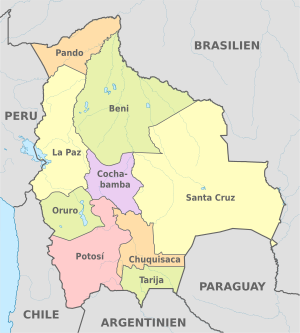Departments in Bolivia
Bolivia is divided into nine constitutionally autonomous departments . Departamentos are local authorities that were partly formed during the Spanish colonial rule ( viceroyalty of the Río de la Plata ), but whose borders have often shifted over time. Most recently, in 1938, President Germán Busch Becerra founded the lowland department Pando, a secession from La Paz. Each department is headed by a governor (gobernador) who is elected by the people. The departments are in turn subdivided into 112 provinces ( provincias ) and these in turn are subdivided into 339 municipalities . The population of each department as well as the lower levels can decide by referendum whether they want to give themselves their own constitution of autonomy or whether they want to continue to exclusively follow the guidelines of the superordinate constitution.
| Surname | Area 1 | Area comparison | Residents 2 | Density 3 | HDI 4 | Capital | ISO code 5 | Established after Bolivia's independence |
|---|---|---|---|---|---|---|---|---|
|
|
213,564 | Belarus | 425.780 | 1.99 | 0.703 | Trinidad | BOB | November 18, 1842 by José Ballivián |
|
|
51,524 | Bosnia and Herzegovina | 600,728 | 11.66 | 0.667 | Sucre | BO-H | January 23, 1826 by Antonio José de Sucre |
|
|
55,631 | Croatia | 1,938,401 | 34.84 | 0.681 | Cochabamba | BO-C | January 23, 1826 by Antonio José de Sucre |
|
|
133,985 | Greece | 2,741,554 | 20.46 | 0.693 | La Paz | BO-L | January 23, 1826 by Antonio José de Sucre |
|
|
53,588 | Netherlands + Flanders | 490.612 | 9.16 | 0.700 | Oruro | BO-O | 09/05/1826 by Antonio José de Sucre |
|
|
63,827 | Latvia | 109.173 | 1.71 | 0.720 | Cobija | BO-N | 09/24/1938 by Germán Busch Becerra |
|
|
118.218 | Bulgaria | 798.664 | 6.76 | 0.599 | Potosí | BO-P | January 23, 1826 by Antonio José de Sucre |
|
|
370.621 | Germany | 2,776,244 | 7.49 | 0.758 | Santa Cruz de la Sierra | BO-S | January 23, 1826 by Antonio José de Sucre |
|
|
37,623 | Switzerland | 508.757 | 13.52 | 0.721 | Tarija | BO-T | September 24, 1831 by Andrés de Santa Cruz |
| total | 1,098,581 | Central Europe | 10,389,903 | 9.46 | 0.692 |
1 : in km², source: INE
2 : 2012 census
3 : inhabitants per km²
4 : index of human development
5 : ISO code according to ISO 3166-2: BO
Additional:
- Under the previous constitution, prefects (prefectos) were appointed and recalled by the president.
- The names of the departments go back in part to the names of the indigenous people (e.g. Cochabamba, Chuquisaca). Others refer to former presidents ( José Manuel Pando ), a border river ( Río Beni ) or are simply named after the capital (e.g. Tarija ).
- The flag of Bolivia has 10 stars because the star for the Litoral Department, which was lost to Chile, was never removed, but the one for Pando was added by law.
- Some of the forerunners of today's departments can be seen on the map of the Río de la Plata state (La Paz, Cochabamba, Potosí and Charcas, the former name of Chuquisaca). At that time Tarija formed a unit with Salta, which is now Argentina:
Individual evidence
- ↑ Instituto Nacional de Estadística , accessed on September 18, 2018.
- ↑ Census: 10.3 million people live in Bolivia agência latina-press from January 23, 2013, accessed on September 18, 2018.


